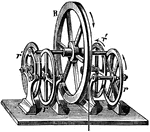Clipart tagged: ‘atwood’
The Atwood Machine
The Atwood machine (or Atwood's machine) was invented in 1784 by Rev. George Atwood as a laboratory…

Atwood's Machine
"Atwood's Machine. This difficulty has however been overcome by a curious piece of machinery invented…
Atwood's Machine
"Machine designed by Atwood to allow the measurement and calculation of the velocities of falling bodies…

Atwood Machine
"The Atwood machine consists of a wheel or pulley, R, over the grooved edge of which are balanced two…